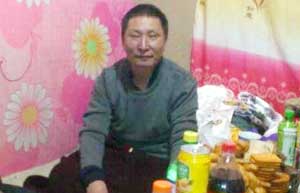
Jigme Gyatso in Labrang after being released from prison.
During his imprisonment, former monk Jigme Gyatso endured severe torture on several occasions and was imprisoned in Gutsa detention center and also in Drapchi and Chushur prisons in Lhasa. In 2006, he was hospitalized and was unable to walk properly due to an injury apparently incurred through torture. There were fears for his life in 2007 after he spoke about prison conditions on a rare visit by the then UN Special Rapporteur on Torture Manfred Nowak to Chushur (Chinese: Qushui) in Lhasa where he was being held. Dr Nowak had been the first official international observer to visit Chushur; he noted that in the prison there was “a palpable level of fear and self-censorship” and called for Jigme Gyatso’s release.
Mary Beth Markey, President of the International Campaign for Tibet, said: “Jigme Gyatso is widely admired for his determination to endure a 17-year incarceration. In the current political climate, where former political prisoners are still restricted and under intense surveillance in Tibet, it is our hope that Jigme Gyatso will be accorded the space to live peacefully and with dignity after his long ordeal.”
Jigme Gyatso, a former Tibetan Buddhist monk, was originally sentenced to 15 years in prison on November 23, 1996 for “leading a counter-revolutionary organisation”, according to the official sentencing document in Chinese, a copy of which was obtained by ICT (ICT report, including a translation from Chinese of Jigme Gyatso’s original sentencing document: Fears for welfare of Tibetan prisoner following meeting with UN Rapporteur – December 1, 2006). He received the longest sentence of a group of five Tibetans who carried out various acts of peaceful resistance, including putting up a Tibetan national flag at Ganden monastery and raising the issue of Tibetan independence. The sentencing document issued by the Lhasa Intermediate People’s Court makes it clear that Jigme Gyatso was regarded by the Chinese authorities as the ring-leader. At the time of his arrest in March 1996, he was running a restaurant in Lhasa after leaving Ganden monastery.
Jigme Gyatso’s sentence was extended after an incident in March 2004 in which he shouted: “Long live the Dalai Lama,” for which he was kicked and beaten, including with electric batons.
Jigme Gyatso became a monk at the age of 21 at Labrang Tashikhyil Monastery in Gansu and later transferred to Ganden Monastery in Lhasa. In the mid-1980s, he visited India and studied for some months at Drepung Monastery in south India.
Following his return to Tibet, he was first detained in March 1996, and held at Gutsa detention center in Lhasa prior to sentencing. A friend of Jigme Gyatso’s who is now in exile told ICT: “Jigme Gyatso was severely tortured at Gutsa. He was held in a dark room, separate to about 17 other Tibetans who were detained at the same time. He was kept in heavy shackles.”
The same Tibetan source said that during his initial detention, Jigme Gyatso managed to smuggle out a letter to a comrade saying that he was likely to receive a long prison sentence, but that he had no regrets. He referred to the 10th Panchen Lama’s long prison sentence and others who had served terms in jail for freedom, including the South African civil rights leader Nelson Mandela. When prison officials discovered that he had sent this letter, Jigme Gyatso was beaten.
In September 1997, security personnel from his home area came to interrogate him and tortured him so severely that he was reportedly unable to move for several days. He also endured torture together with all other political prisoners in Drapchi, following protests coinciding with the visit of a European Union delegation of Beijing-based ambassadors from three different European countries to the prison in May 1998. Jigme Gyatso reportedly sustained head wounds during the beatings in the aftermath of the protests on May 1 and 4 1998.
He told the UN Special Rapporteur on Torture during Dr Nowak’s visit to Chushur that conditions were much worse there than at Drapchi (Tibet Autonomous Region Prison). He said that at Drapchi the food was better, the cells were better lit and ventilated, and the temperatures inside were not as extreme in summers and winters.

